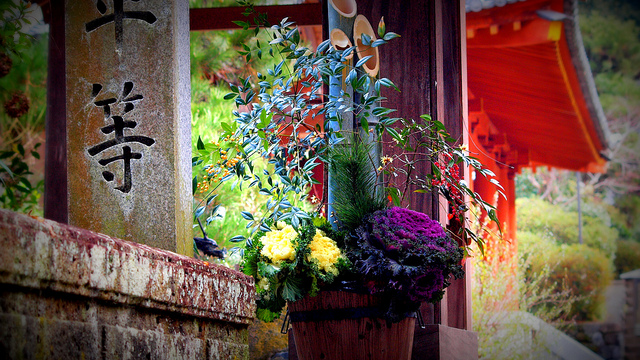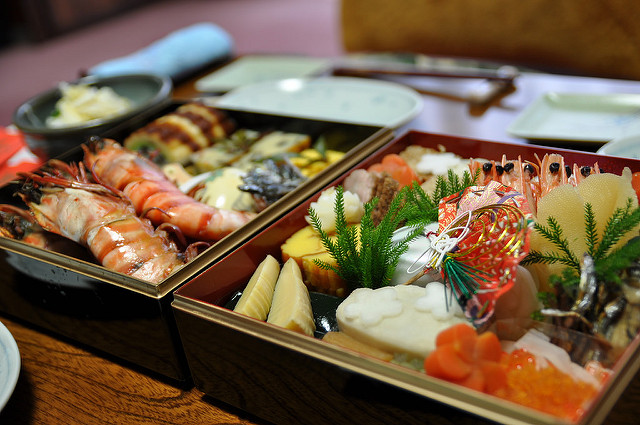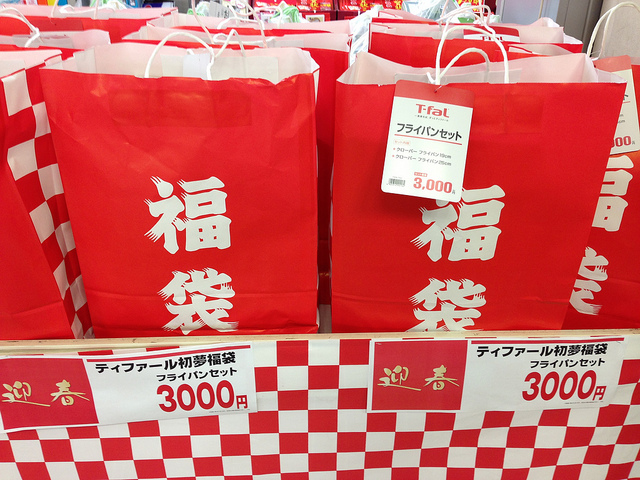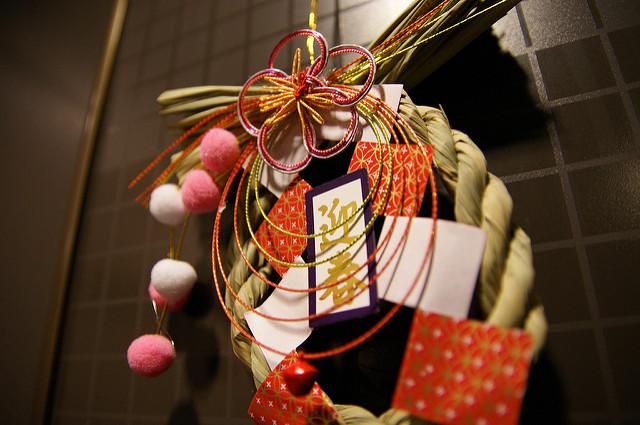For many people, Christmas is the most important holiday of the year. It is a chance to meet family, eat amazing food and give presents to loved ones. In Japan New Year is the biggest holiday, with many people returning home to spend time with their extended families. The festive spirit is reflected throughout Japan, with events held from Hokkaido to Okinawa that anyone can enjoy.
Japanese New Year Traditions
Kadomatsu

If you arrive after Christmas and before January the 7th, you will see that almost every home, temple and shrine has a branch or two of pine or bamboo by the front door. These Kadomatsu branches help usher in good spirits for the following year, ensuring strong harvests and a fruitful crop. Kadomatsu are so important they even have their own festivals, the biggest of which is in Miyakawa City in Fukuoka. Of course, this is merely one of many Japanese New Year traditions.
The New Year in Japan is a spiritual time for many, and if you are interested in witnessing a slice of Japanese cultural history then you might like to go to a bell ringing ceremony. This Buddhist tradition is conducted in many temples throughout Japan leading up to New Year’s Day.
Joya no Kane

Many of the larger and more famous temples in Tokyo, Kyoto and Nara host thousands of visitors, but if you would prefer a quieter occasion there are many smaller temples throughout Japan that will conduct the ceremonies for much smaller crowds. This ceremony, called the joya no kane, offers a view into Japan’s distant past. After the service you can throw in a few yen, ring the bell and pray for good fortune for the coming year.
Hatsuhinode and Hatsumode

If you visit a temple late on December the 31st you will be in good company, as many go to watch the hatsuhinode, or first sunrise of the year. This event is often combined with the hatsumode or first temple visit, where people pray for good fortune for the upcoming year. Depending on the shrine you visit, you may want to pray, or write a wish for the upcoming year. Both are entirely optional! With so many Japanese New Year traditions and so little time to understand them all, it’s best to watch the people around you (or better yet, make some local friends) before jumping in.
Japanese New Year Food
Like in other parts of the world, New Year in Japan often involves staying up all night-this will probably make you hungry for breakfast the next day! Luckily, Japanese New Year food doesn’t disappoint.
Soba

Soba noodles have come to represent a long life and are often eaten on New Year’s Eve. If you are lucky enough to visit more than one prefecture during your stay it is well worth trying this dish in several places, as regional differences lead to a different taste in every area. Sometimes they are prepared with soy, other areas prefer miso and some are plain. A large part of enjoying Japanese cuisine is noticing the big and small differences from city to city.
Osechi Ryori

Osechi ryori is the most famous Japanese New Year food, and is actually a combination of many different dishes often prepared in a bento lunch box. Although the servings are small, the sheer variety of different dishes-not to mention the exquisitely-designed box that perfectly complements them–will more than make up for it.
As with many other aspects of celebrating the new year in Japan, the food in Osechi represents different aspects of life, often associated with how they are written in kanji. For example, black soybeans are kuromame in Japanese, with mame meaning ‘health’ as well as ‘beans.’ Every osechi food has a special meaning and a spiritual benefit, so partake in the Japanese new year tradition of eating without any guilt!
The New Year in Japan Also Brings Shopping

One of the lesser-known traditions of the new year in Japan may be that of shopping. After an evening of new year food and an early morning prayer, you can reacclimate to modern times with a trip to one of Japan’s many department stores. As institutions of modern Japanese living, these stores usher in the new year with special promotions.
The stores partner with famous brands to create a kind of pot-luck bag (called a fukubukuro), where the contents are unknown to the buyer beyond sizes for clothes or overall value for other goods. You might pay 10,000 yen or more for a bag that advertises having items from a specific brand, without knowing what is inside. The obvious downside is that you do not know exactly what you are getting, but the fun is in the surprise and walking away knowing that you got a great bargain. Even Apple has a fukubukuro event, held in its Tokyo stores.
These events are often crowded, with the more popular venues attracting hundreds if not thousands of people lining up for their lucky bag. If you are interested in trying your luck then be prepared to line up early to buy a ticket, and bring something warm to keep the Winter chill at bay. Make sure to check Facebook or Twitter for last minute changes, and be aware that not all of the stores have English language websites. In this case, research is the key to good luck!
Japanese New Year is a Great Time to Stay Connected-with SIM or WiFi!
There is no better time to visit Japan than the start of a new year and with so many festivals, special dishes and sales to navigate it might be tricky to decide what to do. With a rental SIM card or WiFi router from Sakura Mobile, you can find this year’s most awesome places to watch the first sunrise, grab breakfast and then find the best sales. If you stay connected, then all you need to worry about is enjoying the great food and unique atmosphere of a Japanese New Year.



